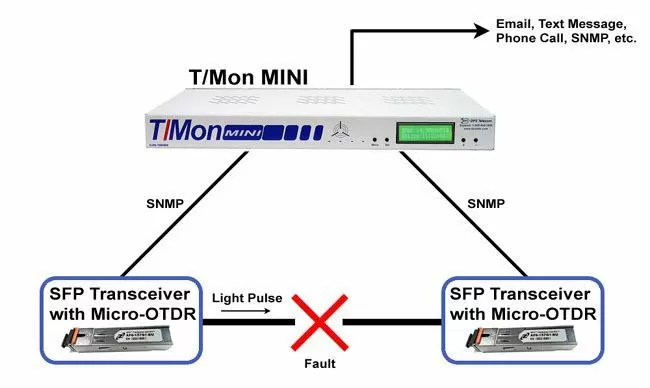Download our free Monitoring Fundamentals Tutorial.
An introduction to Monitoring Fundamentals strictly from the perspective of telecom network alarm management.
1-800-693-0351
Have a specific question? Ask our team of expert engineers and get a specific answer!
Sign up for the next DPS Factory Training!

Whether you're new to our equipment or you've used it for years, DPS factory training is the best way to get more from your monitoring.
Reserve Your Seat TodayMore and more companies are using fiber these days, but aren't taking the necessary precautions to avoid costly outages. Here are the primary reasons to monitor fiber faults:
New Micro-OTDR Technology Lets You Quickly and Accurately Detect Faults
The key to avoiding outages caused by fiber faults is early detection. With advanced notification of broken links and faults, you'll instantly get the upper hand in preventing outages.
How does this fiber fault detection technology work? Whenever the data link breaks, a pulse of light is instantly shot through the optical fibers and is reflected back. The timing on the returned pulse pinpoints the location of the fault.

Traditionally, many fault detectors were plagued with poor performance and operational problems. First, they would occupy an entire optical shelf, which is inefficient. Secondly, they were sensitive to the noise caused by the return reflections.
However, a new "reflection immune" design overcomes these previous limitations by using special firmware to make these single fiber, single wavelength (SFSW) SFP Transceivers immune to reflections. This transceiver is also capable of CWDM data transport in normal use. You won't have to dedicate an entire fiber for monitoring, nor will you sacrifice a CWDM channel, so you'll have more optical fibers for revenue generation.
The bottom line is: you're instantly notified of faults in your fiber transports. This saves you operational expense dollars and helps you quickly get back online during outages (such as disaster-recovery situations).
Integration with Alarm Monitoring
Detecting a fault is just the first step in the equation. Ideally, whenever the data link is broken, you should quickly be notified (via email, SMS text message, phone call, SNMP, etc.). With support for up to 64 devices, the T/Mon provides thorough coverage over all Micro-OTDR fault detectors.

Without the right visibility, a fault could go unnoticed for far too long. The T/Mon provides the means to keep you apprised of all faults and breaks in your fiber transports.
Learn More About Fiber Fault Monitoring
To learn more about this new technology and how to improve the reliability of your fiber network...
To receive a price quote or ROI analysis...
Call 1-800-693-0351